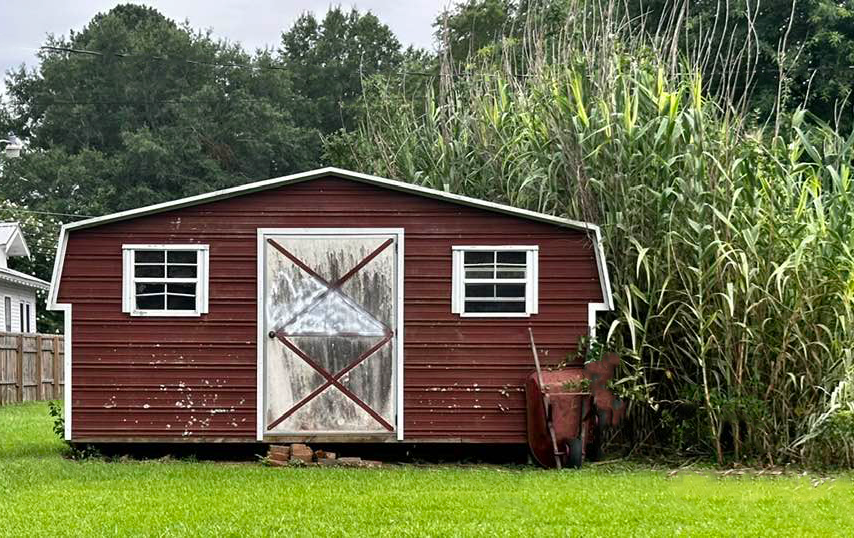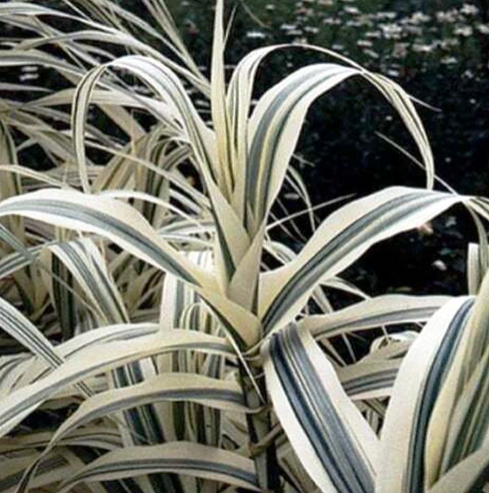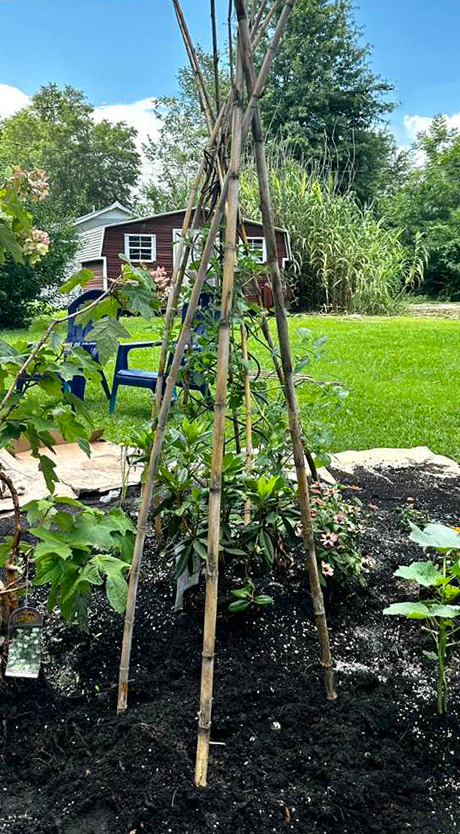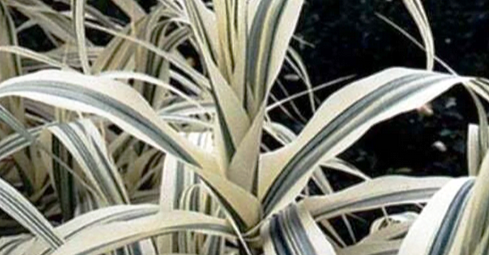
The Peppermint Forest and the Honeysuckle Hotel
This is an ugly spot in my yard. When I first looked at this property, I nearly ran when I saw this view. But after two months here, I am beginning to soften about this scene. The plant, which I later learned was Giant Peppermint Cane, is a type of reed grass. It looks like a huge houseplant to me.

Image Credit: Serenity Grounds
“Arundo ‘Peppermint Stick’, imported from the Shanghai Botanical Garden by the late plantsman Greg Speichert…. Arundo ‘Peppermint Stick’ forms sturdy 12′ tall canes, adorned with wide green and white striped leaves.
“A low maintenance plant once established. Fast growing plant.” Serenity Grounds
Deer Resistant
Height: 12-14′ feet
Spread: 6′ feet
Exposure: Full sun
Zone: 5-9
When I first looked at my current property, the canes out back appeared to be dead. My lawn person told me that she would get rid of it, but doing so would cost me. I scratched my head and assumed a let’s-wait-and-see position. Even if the reeds remained dead, they provided a privacy fence, and that was pretty good, in my opinion. But as the canes became greener, I decided that I actually liked my peppermint patch. I decided to research this guy a little more.
“Description
‘Peppermint Stick’ giant reed grass is a cultivar in the Poaceae (grass) family. It is native to a wide range from Saudi Arabia across China and Japan to Malaysia. Peppermint Stick can grow 10 to 20 feet tall and spreads up to 10 ft. The variegated leaves of this cultivar maintain their color during the growing season. The large purplish-brown plumes appear in late summer and look nice swaying in the breeze. This cultivar generally doesn’t set seed.
This grass requires a large area to grow in and can be used as a focal or specimen plant, often in botanical garden type settings. It is happiest in rich, damp soil, but will tolerate almost any conditions you give it. Cut it to the ground in winter and divide as needed to control the size of the clump.
“Insects, Diseases, and Other Plant Problems: The species is listed on various government invasive weed lists in Canada and the USA, where it outcompetes other plants for limited water resources.” North Carolina Extension
“Arundo ‘Peppermint Stick’ forms sturdy 12′ tall canes, adorned with wide green and white striped leaves. In fall, the clumps are topped with 18” tall bronze-colored plumes. Arundo may get too large for small gardens, but it is NOT an invasive plant (displacing natives in functioning ecosystems), since it neither runs or produces viable seed.
“Interesting factoid:Arundo donax is the source of reeds for wind instruments.
“Arundo donax is also a great cut for flower arrangements, both the foliage in new growth, or all summer long, as well as the glorious large flower heads in fall. The foliage lasts for several weeks in a flower arrangement.
“In mild winters, or a zone 8 winter, the stems do not die to the ground and put out side shoots from most nodes. These small side shoots can be rooted.
“Maintenance consists of cutting the stems to the ground before new growth starts in the spring. This need not wait until then if one wants to cut the stems down earlier. Though a matter of opinion, the stems that survive winter and produce multiple side shoots are a bit shabby looking.
“Arundo donax ‘Peppermint’ thrives in full sun in average to wet soils. It will perform quite well in part shade, though is more likely to lean when grown in too much shade.” Plants Delight Nursery
VIDEO created by Andy Pulte for “Landscape Plant Identification, Taxonomy and Morphology” a plant identification course offered by the Department of Plant Sciences, University of Tennessee.

Peppermint Cane Transplant in Jacki Kellum Garden
July 6, 202
I launched a campaign to transplant bits of my peppermint stick to other places where I wanted a privacy screen, and I am almost surprised that the transplants have been successful. Today, I was cleaning out some of the dead canes.I am using some of them to create garden teepees.

Garden Teepee in Jacki Kellum’s Garden
Created from peppermint cane
July 6, 2023
While cleaning out the dead canes today, and I discovered tons of honeysuckle growing in the cane thicket. I had previously decided to paint the shed beside the cane with neat flowers and a rose vine trailing over the door. The name of the edifice came to me–The Honeysuckle Hotel. After all, I write picture books for children. My imagination has the power to transform the distasteful into magic. As I thought about a little building covered in honeysuckle next to a stand of peppermint bushes transported me to the land of Hansel and Gretel. A name for what I saw came to me:

The Peppermint Forest and the Honeysuckle Hotel
Watch this spot. I see a transformation ahead for this eyesore.

